
HMS Achilles was a Leander-class frigate of the Royal Navy. She was built by Yarrow at Glasgow. She was launched on 21 November 1968 and commissioned on 9 July 1970. She was sold to Chile in 1991 and served in the Chilean Navy as Ministro Zenteno. She was washed away from her berth at Talcahuano by a tsunami following the February 2010 Chile earthquake, and ran aground on the coast a few kilometres to the north. She was scuttled the following month by the Chilean Navy as a danger to navigation.
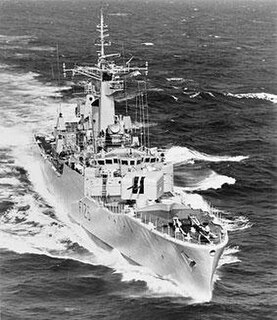
HMS Plymouth was a Royal Navy Rothesay-class frigate. In 1982, Plymouth was one of the first Royal Navy ships to arrive in the South Atlantic during the Falklands War.

HMS Euryalus (F15) was a Leander-class frigate of the Royal Navy (RN). Like the rest of the class, Euryalus was named after a figure of mythology. Euryalus was built by Scotts Shipbuilders of Greenock. Euryalus was launched on 6 June 1963, and commissioned on 16 September 1964.

HMS Cleopatra (F28) was a Leander-class frigate of the Royal Navy (RN). Cleopatra was built at HMNB Devonport. She was launched on 21 March 1964, commissioned on 1 March 1966 and decommissioned on 31 January 1992.

HMS Ariadne was a Leander-class frigate of the Royal Navy. She was launched in 1971, was sold to Chile in 1992 and sunk as a target hulk in 2004.
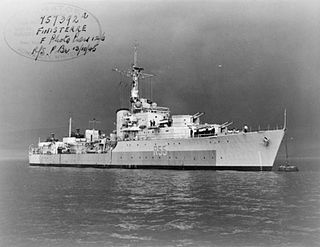
HMS Finisterre was a Battle-class destroyer of the Royal Navy (RN). She was named after one of the battles of Cape Finisterre. She was the first and thus far the only ship of the Royal Navy to bear this name.

HMS Barrosa (D68) was a later or 1943 Battle-class fleet destroyer of the Royal Navy.
The Beira Patrol was a blockade of oil shipments to Rhodesia through Beira, Mozambique, resulting from United Nations trade sanctions on Rhodesia.

HMS Brighton was a Rothesay or Type 12I class anti-submarine frigate of the Royal Navy.

HMS Salisbury was a Salisbury-class or Type 61 aircraft direction frigate of the British Royal Navy. Completed in the late 1950s, Salisbury served through the 1960s and 1970s, participating in the Beira Patrol, blockading against Rhodesia and the confrontation with Iceland over fishing rights that was known as the Cod Wars. Salisbury became a harbour training ship in 1980, before being sunk as a target in 1985.
HMS St Brides Bay was a Bay-class anti-aircraft frigate of the British Royal Navy, named for St Brides Bay in Pembrokeshire. In commission from 1945 to 1961, she served in the Mediterranean and Eastern Fleets, seeing active service in the Korean War.
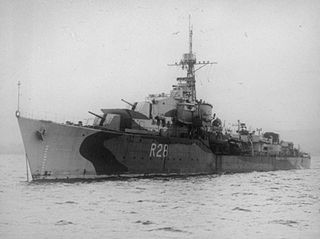
HMS Verulam was a V-class destroyer of the British Royal Navy that saw service during the Second World War.
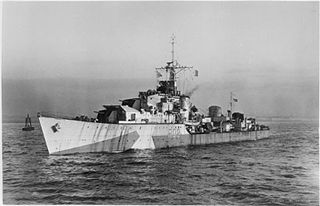
HMS Zest was a Z-class destroyer of the Royal Navy that saw service during World War II.

HMS Carysfort was a C-class destroyer of the Royal Navy. She was ordered in 1941, originally under the name HMS Pique.
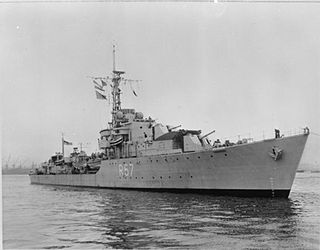
HMS Cossack was a Royal Navy C-class destroyer launched on 10 May 1944.
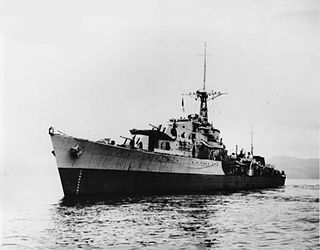
HMS Cassandra was a C-class destroyer of the Royal Navy, ordered in February 1942 from Yarrow Shipbuilders. She was originally to be named HMS Tourmaline but this was changed to Cassandra in November 1942 to fit her revised class name. She was laid down on 30 January 1943 and launched on 29 November 1943.

HMS Chieftain was a C-class destroyer of the Royal Navy that was in service from March 1946, and which was scrapped in 1961.

HMS Comus was a C-class destroyer of the Royal Navy, built by Yarrow at Scotstoun, Glasgow. She was launched on 24 August 1943 and commissioned on 20 December 1946.

HMS Contest was a C-class destroyer of the Royal Navy, built by J. Samuel White, Cowes. She was launched on 1 November 1943 and commissioned on 9 November 1945. She was scrapped in 1960.

HMS Wilton was a Type 2 Hunt-class destroyer of the Royal Navy that served in the Second World War.


















